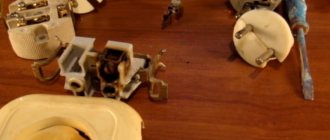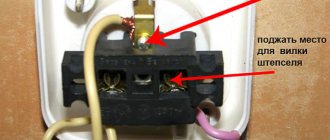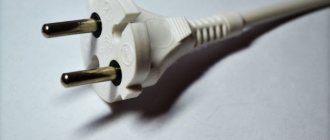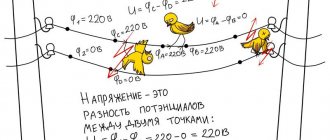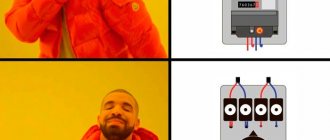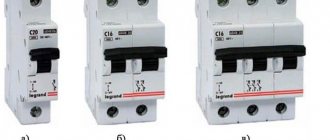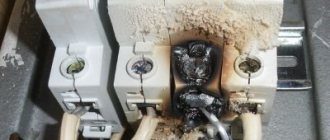Expert author
Yuri Grigorievich F.
Energy Engineer. 40 years in the profession, head of the bureau, deputy chief power engineer of the plant, chief specialist.
For a resident of a modern metropolis, an electric plug looks like a retro device. They were replaced by automatic switches, RCDs (residual current devices), and differential circuit breakers.
Nevertheless, traffic jams have not yet outlived their usefulness. They reliably protect electrical equipment from current overloads. Operating equipment is subject to adverse influences and has a specified service life. Therefore, electricity consumers have to face a situation where the plug in the electric meter is heating up, and they have to find out the reasons. In reality, it is located next to the electric meter, and not inside it.
Fuse selection procedure
To ensure uninterrupted and safe operation of the electrical network, fuses must be selected taking into account the expected operating conditions. To do this, the general power indicators of the operated devices are summed up.
A simple calculation example. In the house it is possible to simultaneously turn on the following electrical appliances with power indicators:
- refrigerator (450 W);
- electric stove (6000 W);
- microwave oven (2000 W);
- TV (180 W);
- washing machine (800 W);
- lighting devices (400 W).
The total value of the electric current is calculated using the formula:
A = ∑Р/U, where:
- A is the desired current value in amperes;
- ∑Р – the total power of electrical appliances, in this case equal to 450 + 6000 + 2000 + 180 + 800 + 400 = 9830 W;
- U – rated voltage value equal to 220 V.
Substituting the numbers into the formula, we get:
A = 9830/220 = 44.68 A.
Circuit breakers are manufactured with different current limit values. The closest standard model in terms of current is rated at 50 A.
Additionally, you will need to check the cross-section of the electrical wiring wires for the total power of electrical appliances in order to eliminate the risk of thermal overheating of the network. The indicator is checked against the table, depending on whether copper or aluminum wiring is used:
In the example given, the cross-section of the wires must be no less than:
- for copper – 6 mm;
- for aluminum – 10 mm.
If it turns out that the cross-section of the wire in the home network is less than specified, it is recommended to change the wiring to eliminate the risk of fire and failure.
It is recommended to purchase circuit breakers instead of outdated plugs. It is advisable to use a two-pole switch that turns off both phases simultaneously. If you install separate switches on the neutral and phase wires, when the contact at zero is disconnected, the phase will remain connected, which is associated with the risk of failure of electrical appliances.
Why is it dangerous?
Excessive heating of electrical devices is dangerous! Especially when it comes to protective devices. Tragic consequences cannot be ruled out:
- Ignition followed by fire.
- Knocks out traffic jams.
- Failure of electrical appliances and equipment.
- Increased risk of electric shock.
Remember: electricity is an extremely dangerous thing and must be taken seriously!
If you can't fix the problem yourself
If there is no access to the electrical panel, which in principle is absolutely unacceptable either in an apartment or in a house, or there is no voltage after the meter, then one logical question arises - where to call and where to go? Naturally, only to the electricity supplier company with whom the contract for its consumption has been signed. Opening closed switchboards or meters is prohibited. If an accident occurs at night and you cannot fix it yourself, then in every area there are emergency services around the clock and the solution to the problem can be entrusted to them.
Now you know why the plugs in the apartment are knocked out and how to determine the reason for the operation. We hope the information provided was useful and interesting for you.
You probably don't know:
- Why does the circuit breaker in the panel trip?
- Reasons for tripping the RCD
- How to deal with low voltage in the network
- How to replace plugs with circuit breakers
Published: November 2, 2017 Updated: November 2, 2017
Acceptable circuit diagrams for connecting machines
The most common scheme for residential electrical inputs is 4 plugs installed above/below the meter. In the old rules, a plug was installed on each wire, on phase and on “0”. Since there is no “0” line in the old residential sector, the wires came from the 380 V access wiring. Therefore, plugs were installed on all lines separately.
The main function of the machines, in the event of a short circuit or overload conditions in the network, is to disconnect all intra-apartment lines from the voltage. To achieve the desired result, you only need to turn off the phase wire; the “0” lines are combined on the “0” bus.
Check what
Everything: from the parameters of the incoming voltage to the technical condition of consumers. Don’t forget to carefully inspect the electrical panel, wires, insulation, all possible contacts and connection points. It’s a good idea to take measurements, but this will require special instruments.
The problem of overheating of the electrical plug in the panel can be resolved by a qualified electrician with the required approval group. Owners are required to follow basic safety rules and take care of the proper condition of devices and equipment.
If you want to live in conditions of electrical safety and energy comfort, check electrical installations, replace and repair if necessary. There is no other option.
This is interesting: The electric kettle does not work: how to find the breakdown and repair it
Possible reasons
Let us consider in detail typical situations that lead to heating and premature failure of electrical plugs (actually fuses).
It is important to know that in addition to the problems listed, there may be others. Eg:
- Deviation of the supply voltage from the nominal value.
- Manufacturing defects.
- The occurrence of unauthorized or accidental parasitic connections.
- Incorrectly selected plugs (designed for other currents).
Wire diameter does not match the load
This happens all the time. The project provided for one load (power consumption and operating modes of electrical receivers), but in reality a different one arose. Another option, quite rare, but it should not be excluded: a designer error at the design stage.
In what cases does the problem arise:
- The object was created decades ago. Over time, an increase in the level of comfort has necessitated the connection of more powerful equipment. These are water heating units, dishwashers, microwave ovens, electric kettles, multicookers, washing machines in the bathroom and kitchen. Living rooms: video equipment, audio systems, powerful vacuum cleaners, irons, smart home systems. Bedrooms: air conditioners, lighting systems. The list is endless, and the wiring is old.
- The number of residents in a residential building or office workers in the offices of administrative buildings is increasing. This entails an increase in electricity consumption due to the installation of new equipment.
- Simultaneous activation of a large number of electrical consumers. Overload occurs.
- Off-season. Cold. The heating is not working yet. Electric heaters are turned on - one of the most energy-intensive consumers.
- The installer made a mistake by installing the wrong wire.
Poor contact
One of the most common causes of electrical problems. A kind of scourge of electricians. Poor contact is possible anywhere: in the plug itself, terminals, clamps, joints and connections.
The lack of a reliable electrical connection sharply increases the resistance, which is equivalent to an increase in load. This causes an increase in temperature (heating, burning of contacts). Resistance is growing again. And so on until the protection works or something burns out.
When analyzing the problem that has arisen, it will be instructive to know:
- Why does one plug on the electric meter get hot? For a specialist, this is not a question, but rather an indication that it is here, in this “phase,” that one must look for the cause of the malfunction (in most cases, again, poor contact).
- Is the zero heating up? Unreliable electrical contact or increased load caused by the influence of higher harmonics (electric ovens, LEDs, gas-discharge lamps, switching power supplies, inverter electrical machines).
Insulation failure
Long-term operation, work at elevated temperatures, exposure to aggressive environments leads to the loss of dielectric properties of the insulation. Plus, the wires heat up during operation. It is strongest during emergency conditions. Sometimes damage to insulation occurs during installation and repair work.
This, in turn, leads to electrical leaks, heating of the insulation, conductor and, as a result, overheating of the plugs.
Turning the electricity back on
Restoring power supply is simple; short instructions on how to turn on the plugs consist of three steps.
- Analyze the situation, identify the malfunction, the electrical panel will help with this. The triggered machine will be in the “Off” position.
- Eliminate the cause of the shutdown.
- Turn AB or plug into working position. Electricity will be restored.
The power supply of an apartment is a complex engineering system. If you have even the slightest doubt about your own abilities, then the best solution to the problem is to call an electrician to carry out restoration work. This will be more reliable and safer.
Procedure in case of no voltage
Below you are offered the answer to the question “the traffic jams in the apartment are broken, how to turn on the lights.” First of all, you need to find out why the plugs on the meter are knocked out. The electricity meter itself is located in the panel, which is usually located at the entrance. If you have plugs with a fuse in your meter, then simply by looking at them you will not find out the reason, just as you will not understand whether the protective device has worked or not.
It’s good that the last few generations of meters have a special indicator for the presence/absence of input voltage. If it lights up, it means electricity is being supplied to your meter, problems arose after it, in the apartment itself, or protective devices on the electricity meter itself have tripped.
Below are step-by-step instructions to help solve the problem of knocked out traffic jams in full:
Step 1
The traffic jams in the apartment have been knocked out, how to turn it on. First, all electrical appliances are disconnected from the network. Then we come to the shield. If there is an automatic machine, return the toggle switch to the “ON” or “ON” position. If there is a button, press the button. If there is a plug with a fuse, unscrew it, replace the fuse and screw it in.
If after these steps the plugs do not come out, then among your electrical appliances there is one that is creating the problem.
Step - 2
If one of the electrical appliances is causing problems, you should find out which one it is. Most likely it either does not work correctly, or there is a short circuit. Therefore, first we inspect all the sockets to which something was connected at the time the plugs were knocked out.
We inspect them for short circuits. If no obvious traces of a short circuit are detected, you should proceed to connecting all electrical appliances to the network in order of priority.
To do this, connect an electric kettle to an outlet, for example. If the plug is not knocked out, then we connect something else and so on. When connecting the next device, wait a little, then connect the next one.
If during the next connection, for example, a refrigerator, the plugs are knocked out, then we take and connect another electrical appliance to the same outlet. If in this case everything is fine, then the refrigerator is to blame: either it puts an excessive load on the electrical wiring, or it is not working properly
Step - 3
It also happens that all the devices are connected, but the machines still work with enviable regularity, then the reason for this behavior is an overload of the electrical network. This can be solved by replacing the used machines with a machine of a higher rating, and also in case of poor condition of the electrical wiring - by replacing it.
Do not forget that in humid places the cause of knocking out the plugs may be the accumulation of moisture.
Using the tips above, you will always know what to do if the traffic jams are knocked out. The most important thing is to never forget about safety precautions. Electricity is no joke; negligence here is unforgivable.
Author Polina Ivanova asked a question in the Technology section
The plugs are knocked out and they won’t turn back on, they turn off again, what should I do? and got the best answer
Answer from KERKLook for a short circuit. Turn off all the sockets and lights and try to turn on the plugs. If it goes out again, there is a short circuit in the wiring, call an electrician. If it doesn’t go out, turn on everything one by one and see where it goes out again. Deal with this device, chandelier, etc.
Best answers
Vladimir:
The machines hardly heat up. If you feel heating, there is a problem. Either the contacts on the machine are loose, or the machine itself is faulty. More often the second. Change the machines, otherwise you may get burned!
Vugluskr:
Apparently it's sparking somewhere
Andrey Ruban:
Check the quality of contact twisting!!! The load may be small, but the electrician-installer - “disperse” - is important!
KERK:
You listed the load, which is already up to the throat for a 16 A machine. By the way, these are not introductory machines, but group machines. Install a 25 A circuit breaker on the outlet line.
Alexander Zatsarinny:
I looked on the Internet for a 12BTU split. Power is about 3 kW, i.e. current 13.5 A. And also an oven...
Know this:
Dmitriy! There is no such thing in electrical engineering... “they get very hot! “Is it strong - 30-50-80-120- degrees? How much do you have? For example, 50 degrees, this is when the hand has difficulty holding the radiator housing... Modern electronics operate normally if the temperature of the elements has even reached 120 C. That is, the water is boiling, but for electronics it is still cool. The limit according to the Technical Specifications is set at 250 C... A little more and the tin melts... But elements have already been developed and are being used, for which the norm is an operating temperature of 550 degrees (670 - and lead melts). And above that, this is already overheating... Didn't you know? If the machine does not knock out, then the power loss is small and everything is in order. In electrical engineering, the heat generated by the device itself is proportional to the Energy loss. In any case, if the hand endures, everything is fine... And without any instruments it’s clear...
Alexey Gurov:
As a rule, the body of the machine is made of ABS plastic, but heating above 70 degrees is no longer normal. You have listed loads that already exceed the rated load capacity of 16-amp circuit breakers. You should consider replacing the breaker with a 25 Amp or not turning on the loads at the same time. And, of course, check the quality of the contact tightening on the machine. It happens that over time the tightening weakens, due to the fluidity of the metal of the conductors, the transition resistance increases and the heating increases. This can lead to big trouble.
What you need to know in advance
First, if you have knocked out old-type plugs with fusible inserts, under no circumstances put bugs in them, but now not only for safety reasons. Modern household appliances are full of electronics. A roughened fuse does not repair or eliminate the source of the problem. Connecting anything - from a tablet to an iron to a washing machine - to a faulty network can cost repairs many times more expensive than buying a couple of circuit breakers that can completely replace a current circuit breaker.
Secondly, before determining the reason for the operation of the automatic protection, everything that is plugged into sockets or through standard switches must be turned off. Disconnections and test starts are carried out only on de-energized wiring sequentially for consumers: turn off the general circuit breaker (see below) or circuit breakers, remove all plugs from the sockets, turn off the switches. You need to check some device or lamp - plug it into a socket or switch, turn on a common circuit breaker or plugs. To check, you need to connect the next device or lamp - turn off the general automation again, connect it, etc.
Handy tools for checking the presence of voltage in sockets
Third, let’s assume that you don’t have a tester, a phase indicator, and you have no idea what it is. In this case, you can check the presence of voltage in the apartment during a test turn-on, without risking yourself and expensive equipment, using a phone charger with a light indicator (on the left in the figure) or a rechargeable LED flashlight (on the right). The charger is plugged into the socket without the phone, and the flashlight is plugged in without turning on the light. No regulatory documents provide for the possibility of using these devices in this capacity, but for an amateur they are even safer than a phase indicator and a tester: due to inexperience, it is impossible to grab the bare part of the probe or try to measure the voltage with a tester turned on to measure current. The “quasi-indicators” themselves on the emergency network can fail (the conductors inside them are very thin), but they are inexpensive and repairable. However, we are getting ahead of ourselves, first we need to get to where it was knocked out.
VShch and ShchA
Protective automation in an apartment is most often mounted next to the electric meter on the input switchboard of the VS. If the protection is with plugs, the VSC can be completely antediluvian (pos. 1 in the figure), poorly made, pos. 2, but next to the VShch there is always a distribution box (dispenser, “dose”, shown by the red arrow). Wiring branches spread out from the dispenser throughout the rooms. So, you cannot open the dispenser without being an electrician. In this case, the source of the malfunction must be sought by test switching on (see above and below).
Introductory boards and automation board in the apartment
In an apartment with a modern type switchboard (item 3), the search for why the protection is knocked out begins by sorting out the wiring branches: they are connected through separate circuit breakers at currents lower than the common one (the main one). In this case, first turn off the branch machines, turn on the main machine, and, turning on the branch machines one by one, find the faulty one, and then check it, as in the previous one. case. If apartment meters are on the staircase, then instead of a power supply in the hallway there will be an automatic switchboard. In this case, it will be more difficult to find the reason for the reactivity protection, see below.
How to choose a good circuit breaker
You probably already realized that first of all you should pay attention to European manufacturers. Everyone knows them: Hager, Schneider, ABB, Eaton and others
Even their budget series are head and shoulders above their Chinese counterparts.
Cheaper means worse?
One point is important here: the concept of “budget” is different between Europeans and Chinese. If the Chinese save on materials in order to reduce costs, then their European colleagues have a different approach:
- Instead of two self-clamping terminals, use one. Because of this, installation is more difficult, but the performance is not reduced;
- Remove color indicators. They are not always necessary at home, but the cost of production is cheaper;
- Inability to connect accessories. Without additional connectors, the price will be lower.
Don’t the “top” manufacturers have any defects?
Among “Europeans” it is very rare, but marriage also occurs. Therefore, before purchasing, do a visual inspection:
- The case must be intact, all fastenings are in place, and the terminals are not loose. If everything is not in order, it means it has probably been dropped or, even worse, taken apart. Then, take something else;
- All markings and the brand logo are applied with a laser, so they should not be erased. If the paint is a little smeared or worn out, then it is most likely a fake;
- A good machine gun should not be too light. The greater the weight, the more metal the manufacturer used in the mechanism, which means higher reliability;
- Click the handle. It should change position with medium pressure. If it sticks or moves too easily, this indicates defects in the design.
What is breaking capacity?
This is one of the parameters measured in kiloamperes (kA). When a short circuit occurs, a very high current begins to flow through the network. The breaking capacity shows at what maximum the release will react. If the short-circuit current is higher, the protection will not work.
Read: Features of open and hidden wiring
Typically, in household networks, the short-circuit current does not exceed 3 kA, which corresponds to the minimum specified characteristics. But the higher the indicator, the better. The fact is that to increase the breaking capacity, the manufacturer has to use higher quality metal, which increases reliability.
The EU has a standard according to which the breaking capacity must be at least 6 kA. In the CIS countries there is no clear requirement, but 4.5 kA is considered the unspoken standard. It’s better to take 6kA or more; although you will overpay a little, you will be sure of reliability. Usually the price of such machines is 25-30% higher, but in terms of cost, the difference is only a couple of dollars.
By choosing a good machine from the beginning, you will protect yourself from potentially dangerous problems: crackling, beeping, vibrations, etc. If they appear on already installed modules, it’s probably time for a replacement. At least this is the only way to protect yourself from the consequences; burnout of the shield, breakdown of household appliances and fire.
Haha
Like
Wow
Satisfied
Sadness
I'm angry
